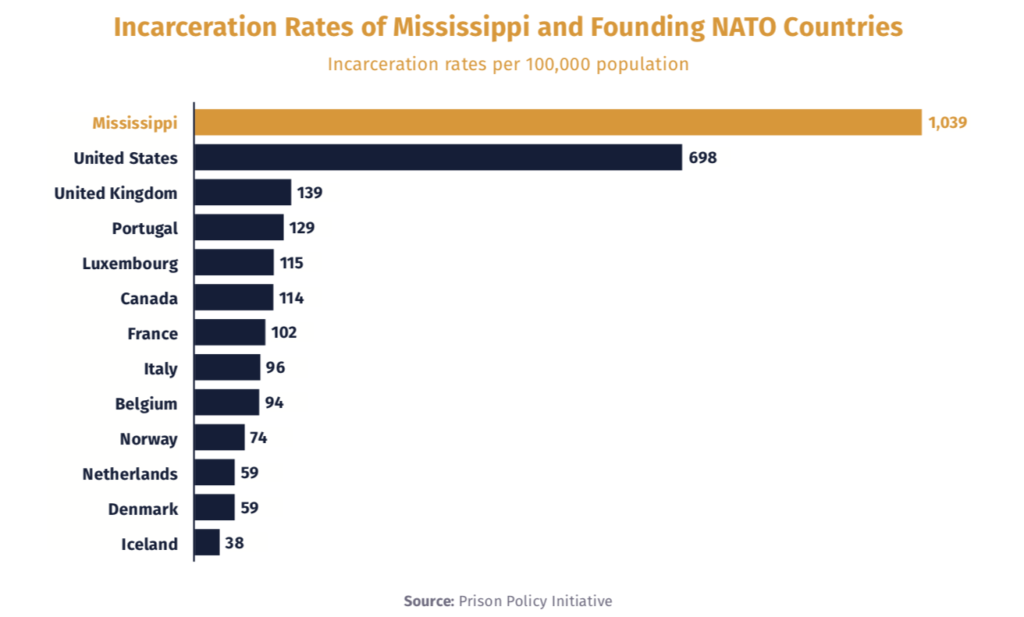Naturally, one of the first questions you will hear is who, or what, is responsible? Is it the governor; is it the Department of Corrections; is it the low pay of prison guards; or the prisoners themselves? Or, is it something else?
Mississippi has begun to address this question.
In 2014, Mississippi policymakers began to study the issue of criminal justice and explore policy options that would help decrease both crime and incarceration while providing better outcomes for people who encounter the criminal justice system. The passage of House Bill 585 began this process by establishing certainty in sentencing and prioritizing prison bed space for people facing serious offenses.
This helped reduce the state’s prison population by 10 percent and generated nearly $40 million in taxpayer savings. Policymakers have also passed several pieces of legislation since then aimed at removing barriers to re-entry for those leaving the prison system.
But this isn’t the end of the story. When adjusted for population, Mississippi still incarcerates nearly 50 percent more people than the average of other states and over 10 times as many people as other founding NATO countries like the United Kingdom, Canada, France, and Italy.

From a budgetary perspective, maintaining the state’s prison system accounts for a large portion of Mississippi’s budget — one of the largest discretionary spending items. In 2019, the state sent over $340 million to the Mississippi Department of Corrections. This does not even account for the additional state, local, and county tax dollars spent on police and jails.
Maintaining one of the world’s largest prison systems for a population our size consumes a large portion of the state’s budget. This should lead conservatives to ask, “Are we getting what we pay for?”
It doesn't appear to look that way.
According to the most recent numbers published by the Mississippi Department of Corrections in 2015, over a third of the people released from state prison end up re-incarcerated within three years. This does not even account for people who might be re-arrested. The U.S. Department of Justice estimates that another third of those released will end up being arrested again within three years.
It also appears that our notoriously high incarceration rate has not provided a commensurate decrease in crime. While crime rates in Mississippi are considerably lower than their peak two decades ago, Mississippians are still more likely to be the victim of property crimes than those in other areas of the country.
And the economic impact of the state’s reliance on incarceration is not limited to tax expenditures. Mississippi has the fourth lowest workforce participation rates in the country. This means fewer people are working or looking for work than in most other states. Research shows that one of the main drivers of this lower economic participation is previous involvement with the criminal justice system.
While the state has been lauded for the reforms to this point, the prison population remains stubbornly high, as Mississippi continues to incarcerate more people per capita than all but two other states. The latest numbers show that the state is falling further behind economically, as our workforce participation is growing at a slower pace than most other states. While other states are moving to reform their criminal justice systems to reduce reliance on prison, Mississippi cannot rest on its laurels.
The state can work to significantly reduce the incarcerated population by prioritizing alternatives like drug treatment for crimes driven by addiction, treating drug possession offenses at the local level as a misdemeanor, eliminating the state’s mandatory minimum habitual sentencing structure that imposes long prison sentences on petty offenses, and ending the practice of automatically sending people back to prison for minor violations while on probation or parole.
The state can also fund alternatives to incarceration like intervention courts, community diversions, and community drug treatment that produce system-wide cost savings. We can also paint the full picture by providing the overall cost of each prison sentence to judges before they impose sentences, like in the federal system.
Parchman houses some of the most dangerous criminals in the state (and potentially the world) who have committed heinous crimes and they should not be on the streets. Most can agree with that. However, we have a much larger prison population than the examples we initially think of. And simply having a larger prison population that most hasn’t made us safer. Rather, as the latest news shows, we need to continue to reform our criminal justice system, and reprioritize and refocus its purpose. Simply giving a raise of a few thousand dollars to prison guards won’t do that.